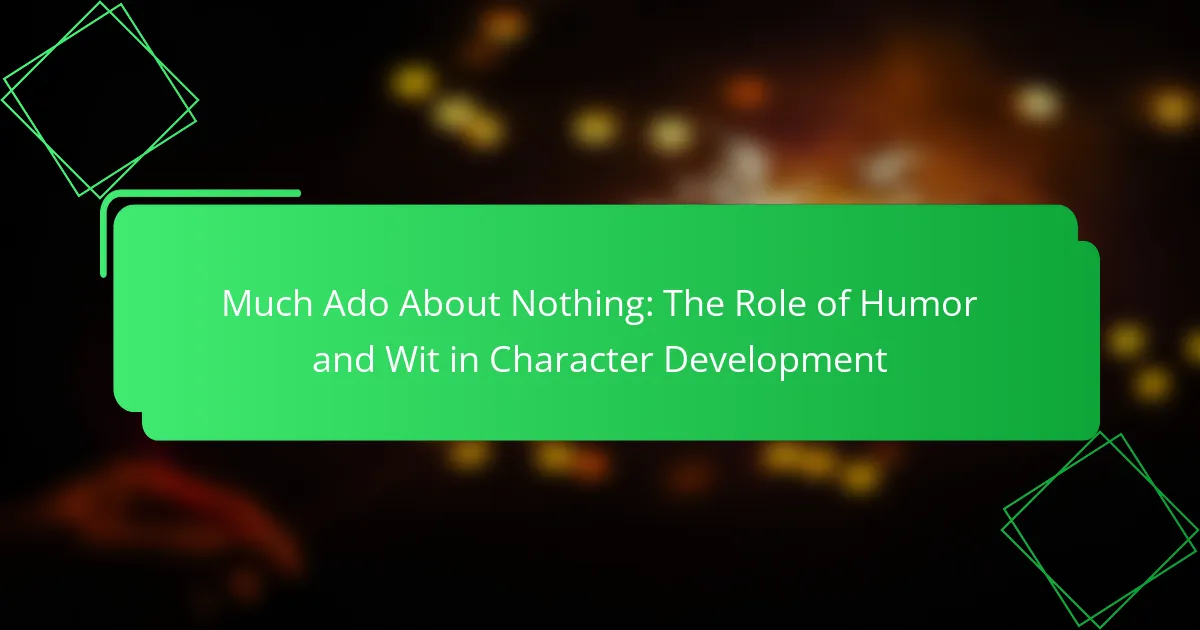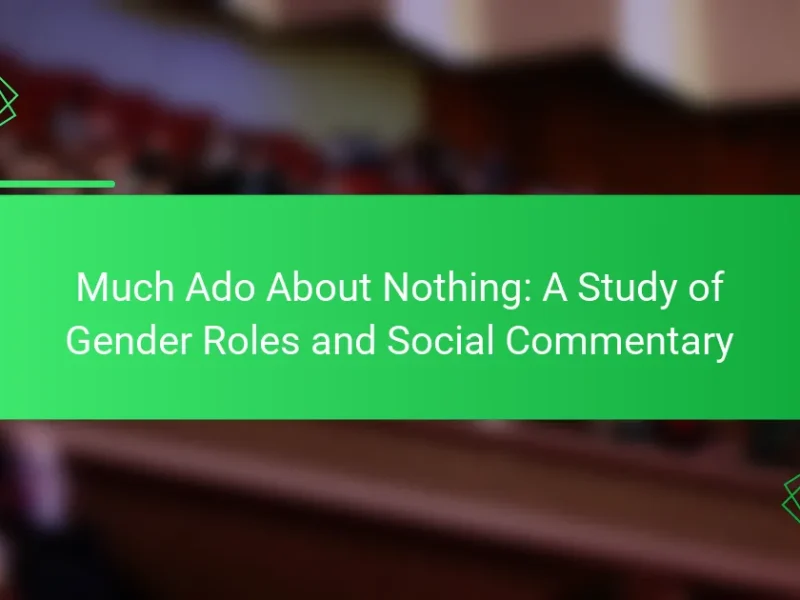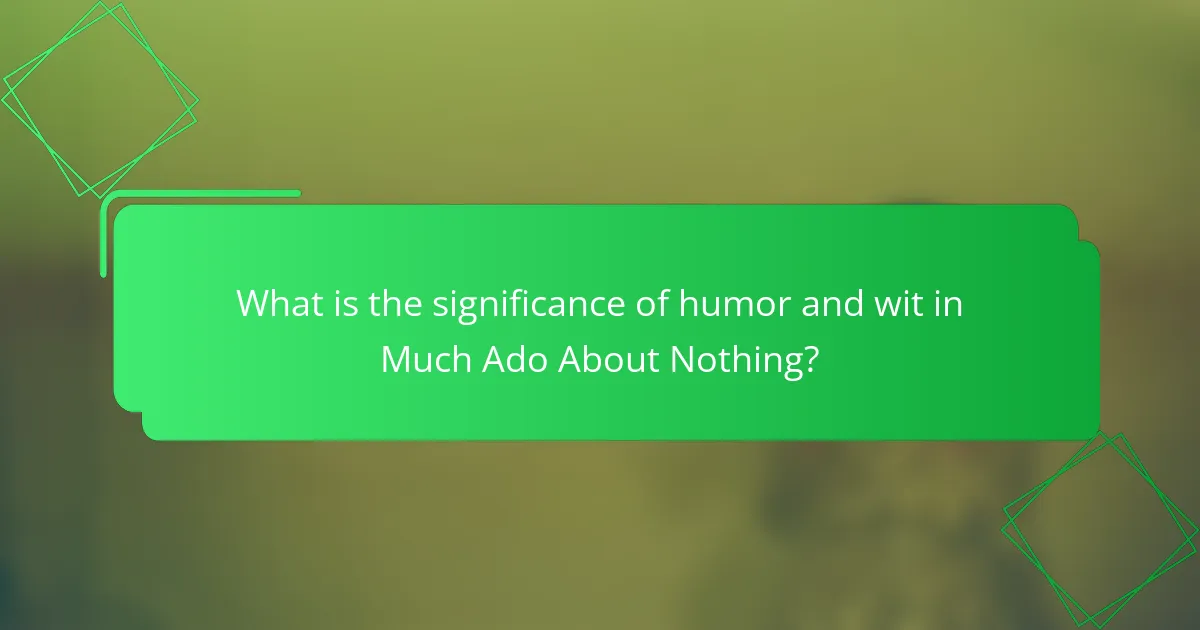
What is the significance of humor and wit in Much Ado About Nothing?
Humor and wit in Much Ado About Nothing serve as essential tools for character development and plot progression. The play utilizes banter and clever wordplay to reveal the personalities of characters such as Beatrice and Benedick. Their witty exchanges illustrate their intelligence and independence. This humor also acts as a mechanism to explore themes of love and deception. For instance, the comedic misunderstandings drive the narrative forward, creating tension and resolution. Additionally, the use of humor allows for social commentary on societal norms and relationships. The lighthearted tone contrasts with serious themes, enhancing the overall complexity of the play. Ultimately, humor and wit are significant for both character dynamics and thematic depth in Much Ado About Nothing.
How does humor contribute to character development in the play?
Humor significantly contributes to character development in “Much Ado About Nothing.” It reveals personal traits and motivations of characters. For instance, Benedick’s witty banter showcases his intelligence and reluctance to embrace love. This humor adds depth to his character arc. Similarly, Beatrice’s sharp wit highlights her independence and vulnerability. The comedic exchanges between characters often serve to expose their insecurities. They also create opportunities for growth and transformation. Humor fosters relationships, as seen in the playful interactions between Benedick and Beatrice. This dynamic ultimately leads to their romantic development. Overall, humor acts as a catalyst for character evolution throughout the play.
What are the key moments where humor influences character interactions?
Humor significantly influences character interactions in “Much Ado About Nothing” through various key moments. One key moment occurs during the witty banter between Beatrice and Benedick. Their playful exchanges highlight their romantic tension and establish their complex relationship. Another moment is when Dogberry’s malapropisms create comedic misunderstandings, affecting the actions of other characters. This humor underscores the theme of miscommunication. Additionally, the humorous deception of Claudio regarding Hero’s fidelity showcases how humor can manipulate perceptions and relationships. These moments collectively illustrate how humor serves as a catalyst for character development and plot progression.
How do different characters use humor to express their personalities?
Different characters use humor to express their personalities through distinct styles and contexts. For example, Benedick employs witty banter and sarcasm, showcasing his intelligence and playful nature. His humorous exchanges with Beatrice reveal both his charm and vulnerability. In contrast, Dogberry uses malapropisms and misunderstandings to highlight his foolishness, providing comic relief while emphasizing his lack of self-awareness. Additionally, Beatrice’s sharp, clever remarks reflect her strong-willed and independent character. Each character’s humor serves as a lens into their motivations and traits, enhancing the audience’s understanding of their personalities. In “Much Ado About Nothing,” humor is not merely for entertainment; it is a vital tool for character development.
Why is wit considered a crucial element in the play?
Wit is considered a crucial element in “Much Ado About Nothing” because it drives character interactions and plot development. The play features sharp dialogues that reveal character traits and relationships. Wit enhances the comedic elements, making the narrative engaging. It also serves as a tool for social commentary, highlighting the absurdities of love and honor. Characters like Beatrice and Benedick exemplify the power of wit in their banter. Their exchanges reflect intelligence and emotional depth. This use of wit ultimately shapes the play’s themes of misunderstanding and reconciliation. The clever repartee creates a dynamic atmosphere that captivates the audience.
What distinguishes wit from other forms of humor in Much Ado About Nothing?
Wit in Much Ado About Nothing is characterized by its sharpness and intellectual engagement. Unlike other forms of humor, such as slapstick or situational comedy, wit relies on clever wordplay and puns. Characters like Beatrice and Benedick exemplify this form of humor through their quick repartee. Their exchanges reveal deeper insights into their personalities and social dynamics. This intellectual humor often critiques societal norms and relationships. For example, Beatrice’s witty remarks challenge traditional gender roles. Wit thus serves a dual purpose: entertaining the audience and advancing character development. The distinction lies in its reliance on language and intellect rather than physicality or absurdity.
How does wit serve as a tool for social commentary in the narrative?
Wit serves as a tool for social commentary in the narrative by highlighting societal norms and flaws. In “Much Ado About Nothing,” characters use clever dialogue to critique social expectations. For example, Beatrice’s sharp remarks challenge gender roles and the institution of marriage. Her wit exposes the absurdity of societal pressures on women. Similarly, Benedick’s banter reveals the superficiality of male honor and rivalry. The use of humor allows characters to navigate sensitive topics without direct confrontation. This technique invites the audience to reflect on the absurdities of their own societal context. Overall, wit becomes a vehicle for deeper insights into human behavior and social structures.
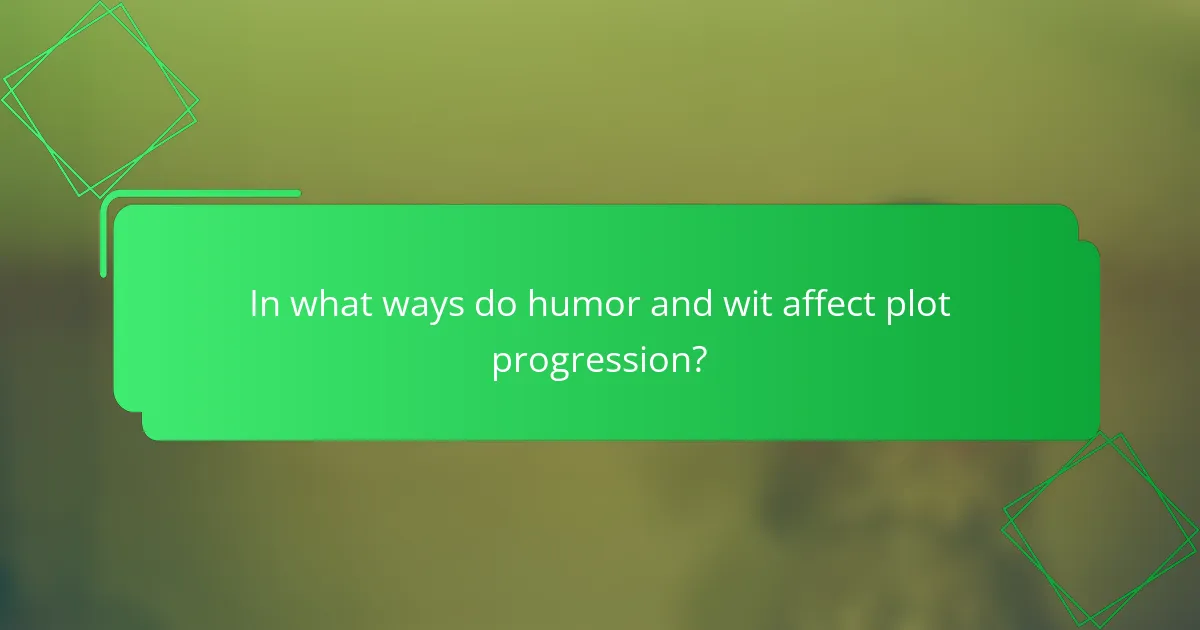
In what ways do humor and wit affect plot progression?
Humor and wit significantly influence plot progression by creating tension and resolution. In “Much Ado About Nothing,” humor often serves as a tool for character interaction. Witty exchanges between characters can advance the storyline by revealing motivations and relationships. Humor can defuse conflict, allowing characters to navigate challenges more easily. Additionally, comedic elements can highlight serious themes, prompting deeper audience engagement. The use of humor often leads to unexpected plot twists, keeping the narrative dynamic. Ultimately, humor and wit shape the pacing of the story, maintaining audience interest and investment in character arcs.
How do humorous exchanges drive the storyline forward?
Humorous exchanges drive the storyline forward by enhancing character relationships and revealing motivations. They create tension and conflict, which propel the plot. In “Much Ado About Nothing,” witty banter between characters like Beatrice and Benedick showcases their chemistry. This humor not only entertains but also deepens their emotional connection. Additionally, comedic misunderstandings often lead to pivotal plot developments. For instance, the humorous deception surrounding Hero’s fidelity creates significant conflict. These exchanges keep the audience engaged while advancing the narrative. Ultimately, humor serves as a catalyst for both character growth and plot progression.
What pivotal scenes are enhanced by witty dialogue?
Pivotal scenes in “Much Ado About Nothing” enhanced by witty dialogue include the interactions between Beatrice and Benedick. Their banter showcases their complex relationship and develops their characters. The “merry war” of words reveals their intelligence and emotional depth. Another key scene is the masked ball, where witty exchanges create tension and intrigue. Additionally, the confrontation between Dogberry and the watchmen offers comic relief through clever dialogue. These moments illustrate how humor enriches character development and plot progression.
How does humor create tension or resolve conflicts in the plot?
Humor creates tension and resolves conflicts in the plot by introducing comedic elements that contrast with serious situations. In “Much Ado About Nothing,” characters often use wit and banter to navigate misunderstandings. This humor can escalate tension by highlighting the absurdity of the characters’ predicaments. For example, Beatrice and Benedick’s playful exchanges reveal deeper emotional conflicts. Their humor serves as a coping mechanism, allowing them to address their feelings indirectly. Additionally, comedic misunderstandings propel the plot forward, leading to resolutions that might not occur without humor. The interplay of humor and conflict ultimately enriches character development and enhances audience engagement.
What role do misunderstandings play in the comedic elements of the story?
Misunderstandings serve as a catalyst for comedic elements in “Much Ado About Nothing.” These miscommunications create humorous situations that drive the plot forward. For instance, mistaken identities lead to characters being duped or confused. This confusion often results in witty banter and clever repartee among the characters. The humor derived from misunderstandings highlights the folly of human nature. Furthermore, these comedic moments provide relief from the play’s more serious themes. They also allow for character development, as individuals reveal their true selves through their reactions to misunderstandings. Overall, misunderstandings are essential for creating humor and advancing character arcs in the story.
How do characters’ misinterpretations lead to humorous situations?
Characters’ misinterpretations lead to humorous situations by creating misunderstandings that escalate conflicts. In “Much Ado About Nothing,” characters often misread intentions or words. For example, Benedick and Beatrice’s witty banter is based on their misinterpretations of each other’s feelings. Their inability to recognize their affection results in comedic exchanges. Additionally, the plot involving Hero and Claudio hinges on mistaken identity and false accusations. These misinterpretations generate confusion and laughter among the audience. Such scenarios highlight the absurdity of the situations, making them entertaining. The humor derived from these misunderstandings showcases the complexity of human relationships.
What lessons about communication can be drawn from these misunderstandings?
Misunderstandings in communication highlight the importance of clarity and context. Clear expression reduces the risk of misinterpretation. Contextual cues help recipients understand the intended message. Humor can complicate communication if not everyone shares the same cultural references. Misunderstandings often arise from assumptions about shared knowledge. Active listening is crucial to clarify intentions and meanings. Nonverbal signals play a significant role in conveying messages. Awareness of different communication styles can prevent conflicts.
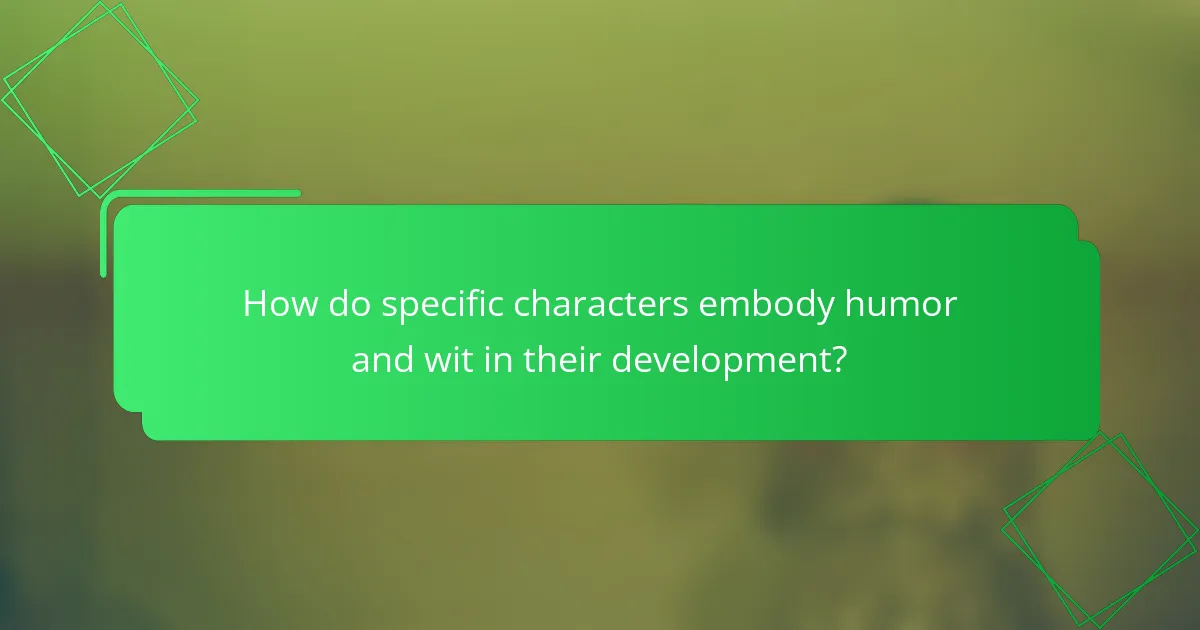
How do specific characters embody humor and wit in their development?
Specific characters in “Much Ado About Nothing” embody humor and wit through their clever dialogue and interactions. For example, Beatrice frequently uses sharp, playful banter to express her intelligence and independence. Her exchanges with Benedick showcase her wit, revealing layers of her character development. Benedick, in turn, displays humor through his self-deprecating remarks and humorous observations about love and relationships. These interactions not only entertain but also deepen their character arcs. Additionally, characters like Dogberry provide comic relief through malapropisms and misunderstandings, highlighting the play’s themes of folly and perception. Their humorous traits serve to advance the plot while enriching the audience’s understanding of their personalities.
What are the comedic traits of Benedick and Beatrice?
Benedick and Beatrice exhibit sharp wit and playful banter as their primary comedic traits. Their exchanges often feature clever wordplay and sarcasm. Benedick is known for his humorous self-deprecation and mockery of love. Beatrice counters with her quick retorts and biting observations on gender roles. Both characters engage in a “merry war” of words, showcasing their intelligence and humor. Their comedic interactions serve to highlight their chemistry and mutual attraction. This dynamic creates comedic tension that drives the narrative forward. Their traits also reflect the themes of love and misunderstanding in the play.
How does their banter illustrate their evolving relationship?
Their banter illustrates their evolving relationship by showcasing the transition from conflict to connection. Initially, their exchanges are marked by sharp wit and playful insults. This tension highlights their misunderstandings and differing perspectives. As the narrative progresses, their banter becomes more affectionate and supportive. This shift indicates a growing trust and intimacy between them. Their humor evolves from a tool of defense to one of bonding. This change reflects their journey towards mutual respect and love. Ultimately, their playful dialogue embodies the depth of their relationship’s development.
What does their humor reveal about their individual characters?
Their humor reveals insights into their individual characters. For instance, Beatrice’s sharp wit showcases her intelligence and independence. Benedick’s playful banter reflects his reluctance to express vulnerability. Claudio’s humor often masks his insecurities about love and honor. Dogberry’s malapropisms highlight his earnestness despite his lack of sophistication. Each character’s humor serves as a lens into their values and motivations. This interplay of humor and character deepens the audience’s understanding of their personalities and relationships.
How does the character of Dogberry contribute to the play’s humor?
Dogberry contributes to the play’s humor through his malapropisms and misguided authority. His misuse of language creates absurd situations that elicit laughter. For example, he often confuses words, calling himself a “watchman” instead of a “watch,” which highlights his incompetence. This comedic effect is further amplified by his overconfidence in his role as a constable. His interactions with other characters often lead to misunderstandings, adding to the humor. Additionally, Dogberry’s serious demeanor contrasts sharply with his foolishness, enhancing the comedic impact. His character serves as a vehicle for social satire, poking fun at the incompetence of authority figures. Overall, Dogberry’s blend of language errors and misguided self-importance generates significant comedic moments in the play.
What unique attributes make Dogberry a source of comic relief?
Dogberry’s unique attributes include his malapropisms, self-importance, and misguided authority. His frequent misuse of words creates humor through absurdity. For example, he refers to “the most senseless villain” instead of “the most sensible villain.” This linguistic confusion highlights his lack of intelligence. Additionally, Dogberry’s inflated sense of his own importance contrasts sharply with his actual incompetence. He believes he is an effective constable, despite his bumbling nature. His misguided authority leads to comedic situations, especially when he gives absurd orders. These attributes collectively make Dogberry a memorable source of comic relief in “Much Ado About Nothing.”
How does Dogberry’s role affect the perception of authority in the play?
Dogberry’s role in “Much Ado About Nothing” undermines the perception of authority. As the comically inept constable, he represents a flawed version of law and order. His malapropisms and misunderstandings highlight the absurdity of his position. This portrayal suggests that authority can be misguided and incompetent. The characters’ interactions with Dogberry often reveal their own superiority. His attempts at asserting control often result in confusion and humor. This dynamic creates a satirical view of social hierarchies. Ultimately, Dogberry’s character challenges the audience’s respect for authority figures in the play.
What practical insights can be gained from the use of humor and wit in Much Ado About Nothing?
The use of humor and wit in Much Ado About Nothing reveals key insights into character relationships and societal norms. Humor acts as a vehicle for truth, allowing characters to express genuine feelings indirectly. Wit often highlights contrasts between appearances and reality, exposing hypocrisy within social interactions. Additionally, humor fosters camaraderie among characters, enhancing bonds and facilitating conflict resolution. For example, the playful banter between Beatrice and Benedick showcases their complex relationship dynamics. Their witty exchanges reveal deeper emotions and mutual respect, ultimately leading to their romantic union. Overall, humor and wit serve as tools for character development, social critique, and thematic exploration in the play.
Much Ado About Nothing is a play by William Shakespeare that utilizes humor and wit as essential elements for character development and plot progression. The article examines how witty exchanges, particularly between characters like Beatrice and Benedick, reveal personal traits and motivations while advancing the narrative. It highlights key moments where humor influences character interactions and serves as a tool for social commentary, emphasizing the importance of misunderstandings in creating comedic situations. The analysis also explores the distinct comedic styles of various characters, including Dogberry, and how their humor contributes to the overall themes of love, deception, and societal norms within the play.
